The stories of Columbia and Jim Rouse are intricately connected. It took many minds to create the planned city, all of which were guided by Rouse’s vision. In his own words, Columbia would be a place that would “uplift, inspire, stimulate and develop the best in man.”
Memorable milestones
Jim Rouse changed the face and focus of Howard County in the 1960’s with the creation of Columbia. However, the planned city was only one piece of his portfolio.
Rouse was a pioneer in the development of suburban shopping centers. The Rouse Company (TRC) developing the first enclosed mall on the East Coast – Harundale in Glen Burnie, Maryland – in 1958.
Decades later, Rouse developed the concept of festival marketplaces; he restored and opened the highly successful Faneuil Hall Market in Boston, Massachusetts in 1976. The Rouse Company followed these accomplishments by creating and opening Harborplace in Baltimore and South Street Seaport in New York City. The part these urban retail centers played in revitalizing their respective cities in addition to the story of Columbia, landed Jim Rouse the cover of TIME magazine in 1981.
An American Hero
Rouse served on President Dwight D. Eisenhower’s Task Force on Housing in 1952 and on President Ronald Reagan’s Task Force on Private Sector Initiatives in 1981.
In 1982, he and his wife Patty, launched the Enterprise Foundation. Its mission is: to “see that all low-income people in the United States have the opportunity for decent, affordable housing and to move up and out of poverty into the mainstream of American life.”
Rouse continued his public service and chaired the National Housing Task Force in 1987. The Task Force issued a report that formed the basis for comprehensive housing legislation. In 1990, this was signed into law by President George H.W. Bush.
In 1995, Rouse received the Presidential Medal of Freedom honor recognizing the achievements of his half-century career. President Clinton hailed Rouse as an American hero who helped “heal the torn out heart of America’s cities.”
Lasting Influence
Rouse helped change the face of cities but, perhaps his greatest legacy is how he inspired others with his optimism. He believed that “what ought to be can be,” and that private enterprise can be harnessed to accomplish good.
Rouse was a prominent national figure, but in Columbia and Howard County he was always ‘Jim’. He lived for much of his life in Columbia in a modest split-level home until his death in 1996.
The Columbia Archives holds the James W. Rouse Manuscript Collection which offers the most comprehensive record of his life and career.
Learn more details about Rouse’s legacy by viewing the timeline below.

Birth
James Wilson Rouse is born on April 26 1914, the fifth child of Lydia Robinson Rouse and Willard Goldsmith Rouse in Bel Air, MD.

First Job
At 13 years old, Jim Rouse got his first job working part-time at the canning factory. To avoid boredom he gave speeches to the machines, honing his superb gift for communication. The image above shows a can similar to those manufactured in the factory in which Jim Rouse worked.
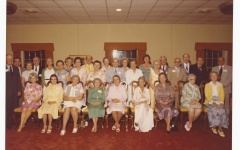
Graduates Easton High School
In 1930, 16 year old Jim graduated from Easton High School having been elected class president. This picture shows his graduating class at its 50 year reunion in 1980.

Attends the University of Hawaii
In 1931, Rouse enrolled in the University of Hawaii. Rouse's time at the University of Hawaii introduced him to a very ethnically diverse population. In later life Rouse credited his time at the University with forever changing his attitude toward race. The image shows a page from Ka Palapala, the 1932 yearbook of the University of Hawaii.
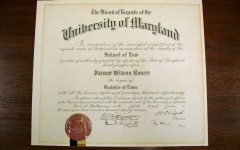
Transfers to the University of Maryland
Rouse transferred to the University of Maryland's School of Law, Baltimore, in 1932. He continued to pursue his studies at night and working at St. Paul Garage parking cars during the day.

Starts at the FHA State Director's Office
In 1936, Rouse is hired as the assistant legal clerk for the FHA State Director's Office while completing his studies at the University of Maryland.
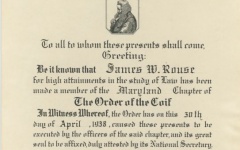
Graduates from University of Maryland School of Law
Graduates from University of Maryland School of Law in Baltimore with a bachelor of law. The attached image shows the Order of the Coif; an honorary scholastic society the purpose of which is to encourage excellence in legal education.

Forms Moss-Rouse Company
In 1936 Rouse joined Title Guarantee and Trust Company and set up a mortgage banking department. Through his work at Title he had met Hunter Moss who had set up a mortgage banking department at a real estate firm. In 1939 they formed their own company – Moss-Rouse.
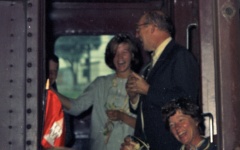
Marries Libby Winstead
In 1941 Rouse marries Libby Winstead. Although they have 3 children: James, Robin, and Ted, the marriage ends in divorce August, 1973. The image shows the family on a trip to Europe.
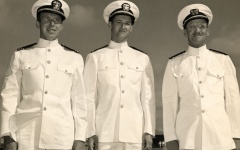
Joins the Navy
Rouse joins the Navy, but defers duty due to pregnant wife. During his military service he works on Admiral John Henry Towers' staff where he meets a number of people who will play a key role in the rest of his life including August Belmont, Sumner Putnam, and Lee Loomis, Jr.

Task Force on Housing
In 1952, rouse served on President Dwight Eisenhower’s Task Force on Housing in 1952. He later went on to serve on President Ronald Reagan’s Task Force on Private Sector Initiatives in 1981.
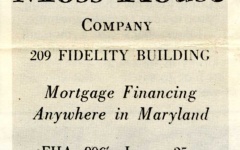
James W. Rouse & Company Inc.
By 1954 Rouse’s interests had expanded from mortgage banking to taking a far greater role in project development. As Moss was more interested in the mortgage banking side of the business, the partners agreed to separate and the James W. Rouse Company was formed.
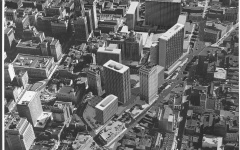
Greater Baltimore Committee is formed
Created in 1955 to help the growth of Baltimore. Rouse was elected as the first head of the Committee. The Committee's work on the planning for Charles Center received national acclaim.


Community Research and Development formed to handle all development business.
In 1957, Community Research and Development is formed to develop and manage shopping centers.
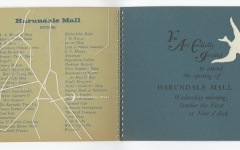
Harundale Mall opens in Glen Burnie, MD
Harundale Mall opens in Glen Burnie, MD. It is the first enclosed shopping center east of the Mississippi.
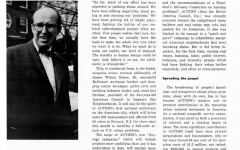
Elected president of ACTION
In 1958 Rouse was elected president of ACTION (American Council to Improve Our Neighborhoods), raising him to a national platform.

Purchases Land For Cross Keys in Baltimore
Cross Keys, a small new community in Baltimore is Community Research and Development’s first venture in developing a community and is a precursor to Columbia. Providing Photo of four men looking at model of Cross Keys. Photo shows - James W. Rouse, Willard Rouse, Charles Jenkins, and Peyton Cochran viewing the Cross Keys model.

Thousands of acres of farmland acquired in Howard County
A member of the Board of Directors of the J.W. Rouse & Co. spotted a sign for 1039 acres that were available in Howard County in 1962. This started the land acquisition for Columbia. Ultimately, 14,000 acres were acquired for The New City.
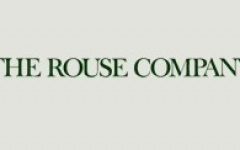
Several Companies Merge
James W. Rouse & Company and Community Research and Development merged under the new name of The Rouse Company.

Wilde Lake Dedication, the beginning of Columbia
Frazar Wilde and James Rouse speak at the dedication of Wilde Lake marking the beginning of Columbia. Frazar Wilde was chairman of the board of Connecticut General Life Insurance Company which had committed the financing to make the development of Columbia possible.

Marries Patty Traugott
Rouse met Patty in Norfolk in 1973 soon after his separation from Libby. They married the following year. Patty had served as a commissioner for the Norfolk Redevelopment and Housing Authority and held a masters in Urban Planning.
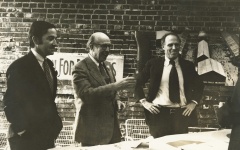
Faneuil Hall Marketplace
Collaborates with Benjamin Thompson in Boston to preserve historic Faneuil Hall Marketplace becoming a model for urban revitalization known as a “festival marketplace”. This image shows Jim Rouse signing the lease following two years of negotiation with the City of Boston. Bob Kenney is shown to the left and Mayor Kevin White to the right.

Steps Down
Rouse retires as chief executive officer from The Rouse Company in 1979 at the age of 65 handing over the leadership to Matt DeVito (pictured). He continued as chairman of the board for a few years.
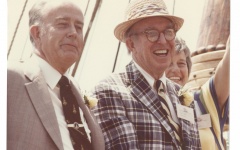
Harborplace opens in Baltimore
Harborplace opens on July 2 1980. Mayor of Baltimore, William Donald Schaefer, declared that the opening of the facility marked the start of a 'Baltimore Renaissance'

Cover of TIME Magazine
In 1981 Jim rouse was featured on the cover of TIME Magazine with the headline ,“Master Planner - Cities are Fun”.
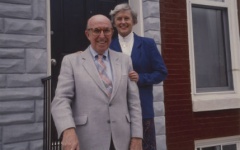
Enterprise Foundation & Development Co formed
James and Patty Rouse formed the Enterprise a Foundation in 1982 national organization dedicated to giving everyone in the United States to a safe and affordable place to call home.
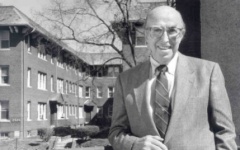
National Association of Homebuilders’ Hall of Fame
In 1987 Rouse w was selected for the National Association of Homebuilders’ Hall of Fame.
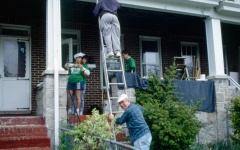
Redeveloping Baltimore
Baltimore ‘s BUILD and the Enterprise Foundation moves to focus on the city's Sandtown-Winchester neighborhood in order to test ideas on affordable housing and other programs.
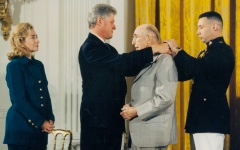
Presidential Medal of Freedom
In 1995, Rouse receives the Presidential Medal of Freedom. President Bill Clinton cites Rouse for helping to “heal the torn out heart” of America’s cities.
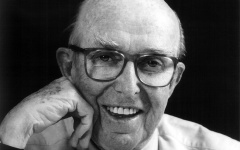
Legacy
On April 9, 1996 Jim Rouse died at home. On his death, President Bill Clinton expressed his condolences saying “His life was defined by faith in the American spirit, and he showed us that we can build communities worthy of the character and optimism of our people.”







